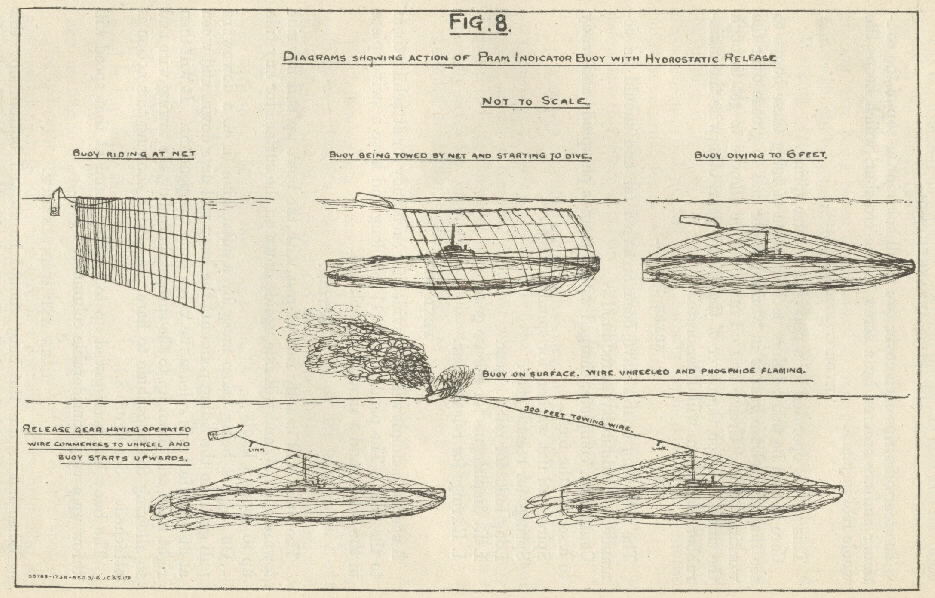anti-submarine net on:
[Wikipedia]
[Google]
[Amazon]

 An anti-submarine net or anti-submarine boom is a boom placed across the mouth of a harbour or a strait for protection against
An anti-submarine net or anti-submarine boom is a boom placed across the mouth of a harbour or a strait for protection against
Isle of Bute during World War II - Anti-submarine net in the Clyde Estuary in Scotland (Item 4)

 An anti-submarine net or anti-submarine boom is a boom placed across the mouth of a harbour or a strait for protection against
An anti-submarine net or anti-submarine boom is a boom placed across the mouth of a harbour or a strait for protection against submarine
A submarine (often shortened to sub) is a watercraft capable of independent operation underwater. (It differs from a submersible, which has more limited underwater capability.) The term "submarine" is also sometimes used historically or infor ...
s. Net laying ships would be used to place and remove the nets. The US Navy used anti-submarine nets in the Pacific War
The Pacific War, sometimes called the Asia–Pacific War or the Pacific Theatre, was the Theater (warfare), theatre of World War II fought between the Empire of Japan and the Allies of World War II, Allies in East Asia, East and Southeast As ...
to protect major US Naval Advance Bases. Some net cutter submarines were used in the war.
History
Submarine nets were first used shortly after the first use of submarines in warfare, duringWorld War I
World War I or the First World War (28 July 1914 – 11 November 1918), also known as the Great War, was a World war, global conflict between two coalitions: the Allies of World War I, Allies (or Entente) and the Central Powers. Fighting to ...
. Because they were a reaction during the war, there was not time to study the best construction methods, or the nets' overall efficacy. But this was also a benefit, because the enemy did not know how effective submarine nets were either. Testing done after the war showed that the nets used during WWI had not been effective, and yet they had acted as an effective deterrent during the war since their weaknesses were not known.
A submarine net is very similar in principle to a boom. While a boom blocks a waterway for surface ships, a submarine net does the same below water. They suffer similar weaknesses. Small ships and submarines will tend to try to slip through gaps. Large vessels are capable of ramming through, even if they are hesitant to do so. The most effective way to prevent ramming is to yield slowly rather than be rigid. By gradually slowing a vessel to a stop the effectiveness of a barrier is greatly increased.
The most extensive use of anti-submarine nets during WWI was the Dover Barrage, spanning the English Channel
The English Channel, also known as the Channel, is an arm of the Atlantic Ocean that separates Southern England from northern France. It links to the southern part of the North Sea by the Strait of Dover at its northeastern end. It is the busi ...
. It was largely effective as a deterrent. There were limited examples of it succeeding and failing. One U-boat
U-boats are Submarine#Military, naval submarines operated by Germany, including during the World War I, First and Second World Wars. The term is an Anglicization#Loanwords, anglicized form of the German word , a shortening of (), though the G ...
was caught in the net, but there were also reports of submarines bypassing the net, on the surface at night, or underwater by slipping through gaps. From war logs there was one example of U-32 getting tangled in the Dover nets. The boat lay on the bottom until night, then surfaced and freed herself and continued on.
Indeed, a net alone is not effective. It must be supported to be useful, generally by surface ships with depth charges.
Scapa Flow is a large natural harbor in Scotland. It was used in WWI and WWII by the Royal Navy
The Royal Navy (RN) is the naval warfare force of the United Kingdom. It is a component of His Majesty's Naval Service, and its officers hold their commissions from the King of the United Kingdom, King. Although warships were used by Kingdom ...
, and secured with submarine nets. In 1918 SM UB-116 successfully bypassed the nets, though was subsequently sunk by a mine.
Examples of anti-submarine nets
* Lake Macquarie anti-submarine boom *Indicator net
Constructed using light steel nets, indicator nets were often anchored at various depths to the sea bed around Allied naval bases during both world wars. They were intended to entangle U-boat traffic of the enemy, even though the submarines often ...
* Naval operations in the Dardanelles Campaign
* Sydney Harbour anti-submarine boom netIsle of Bute during World War II - Anti-submarine net in the Clyde Estuary in Scotland (Item 4)
See also
*Anti-submarine warfare
Anti-submarine warfare (ASW, or in the older form A/S) is a branch of underwater warfare that uses surface warships, aircraft, submarines, or other platforms, to find, track, and deter, damage, or destroy enemy submarines. Such operations ar ...
* Jumping wire (of a submarine)
* Net cutter (submarine)
* Net laying ship
* Torpedo net
References
External links
* {{Cohoes class net laying ships Anti-submarine warfareAnti-submarine weapons
An anti-submarine weapon (ASW) is any one of a number of devices that are intended to act against a submarine and its crew, to destroy (sink) the vessel or reduce its capability as a weapon of war. In its simplest sense, an anti-submarine weapon ...
Auxiliary gateship classes